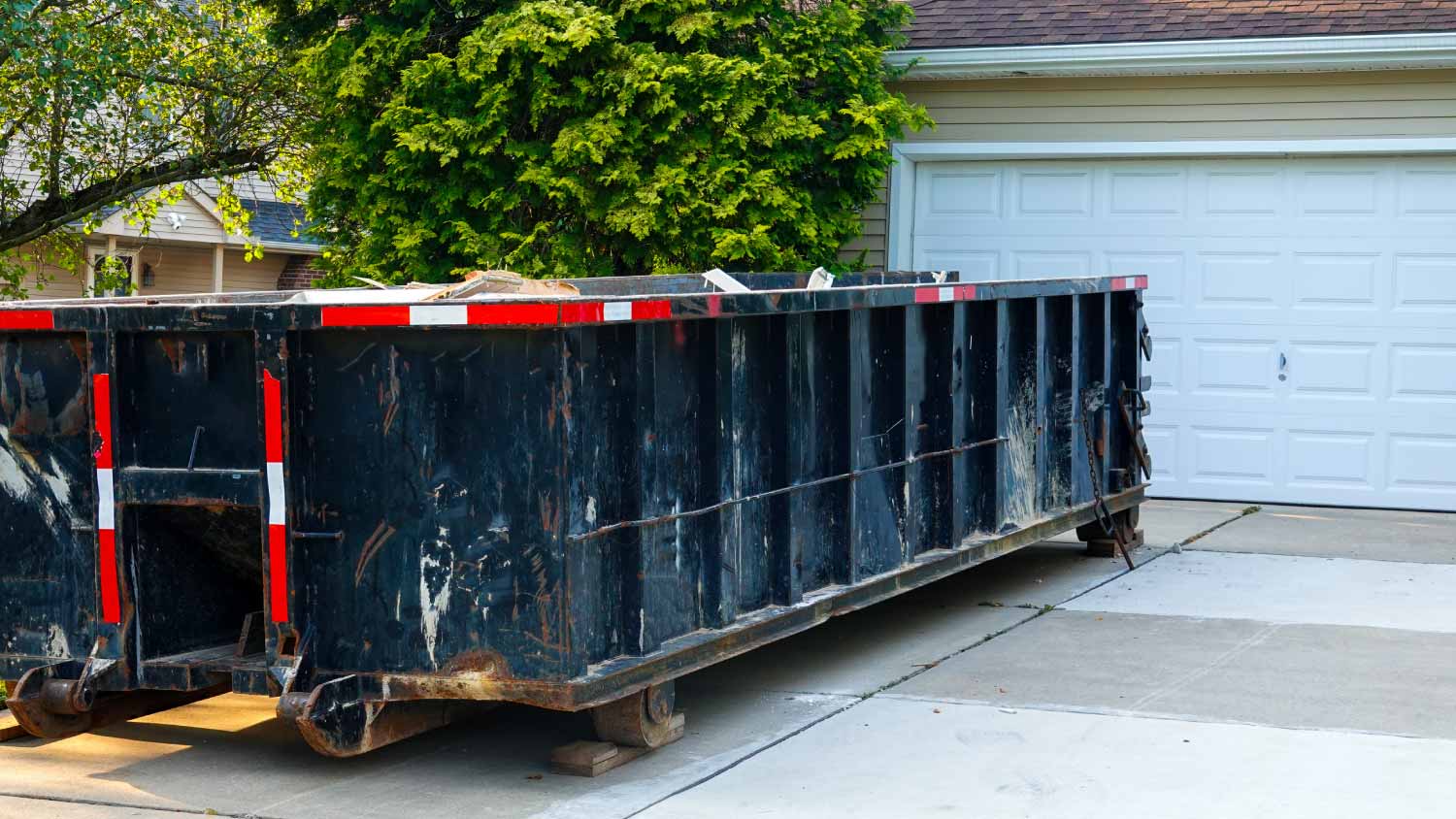
Junk removal costs depend on the volume and type of waste you need removed, but paying a professional saves you time and energy over hauling it yourself.
The average cost of construction debris removal is $450. Your total can range from $300 to $800, depending on the size of the load and the types of materials you remove.


The cost to remove construction debris depends on factors such as volume, weight, type, and the required removal method.
Many companies charge by volume, with average prices of $50 per cubic yard.
Junk removal services cost $100 to $800, while dumpster rentals range from $300 to $500.
Removing hazardous waste increases costs, with most projects ranging from $150 to $300.
Construction debris removal costs $450 on average. However, removal is typically priced by load volume or weight, and your total cost may range between $100 and $1,000. Construction debris can include concrete, drywall, insulation, plumbing, roofing, lumber, trim, flooring, glass, bricks, furniture, cabinetry, dirt, and asphalt, as well as various hazardous waste items. Learn the factors that impact pricing and how to save.

Factors that impact construction debris removal costs include the weight and volume of the debris, labor fees, and geographic location.
Debris removal companies often charge by the cubic yard of construction debris. For example, if you have 10 cubic yards of debris and a company's rate is $50 per cubic yard, your fee is $500.
To simplify volume calculations, many debris removal companies price construction debris removal based on the amount of space the load takes up in the truck used to haul it.
| Truck Volume Used | Average Price Range |
|---|---|
| 1/4 truck | $100–$300 |
| 1/2 truck | $200–$400 |
| 3/4 truck | $300–$600 |
| Full truck | $500–$800 |
Some debris removal companies charge by weight instead of volume. This is a common practice when debris includes heavy materials such as concrete or metal. To calculate load weight, the company will weigh the truck or dumpster used before and after disposal and charge a rate per pound.
You have several options for disposing of construction debris. The costs vary depending on the amount of materials you’re disposing of and how much physical labor you are willing to do yourself. Here are the three most common methods of removing construction debris.
| Removal Method | Cost Range |
|---|---|
| Dumpster rental | $300–$500 |
| Junk removal service | $100–$800 |
| DIY/Landfill | $20–$50 per ton |
Labor costs for debris removal depend on how easy the debris is to access and haul. Companies will either charge a flat rate or an hourly fee. Expect labor to account for $100 to $300 of your total.
Construction debris removal and disposal costs vary by geographic location. Expect higher prices in urban areas where disposal fees tend to be higher, as well as in very remote areas where debris has to be hauled further for disposal.
You can also expect higher costs due to accessibility issues. This can include if laborers have to remove debris from upper floors or navigate an active construction site, difficult terrain, narrow streets, or alleys.
Some construction materials are hazardous. Safe disposal of household hazardous waste requires special handling and specific methods for individual substances. Hazardous waste disposal costs $150 to $300 on average. However, each hazardous material will have its own specific removal cost because each needs to be disposed of at a different facility.
Certain hazardous materials can also require additional labor depending on their location. For example, the cost to remove asbestos usually ranges from $5 to $20 per square foot but can reach as high as $150 per square foot if the asbestos is in an exterior location.
Costs are usually based on load size or total weight. Typical removal costs for various hazardous waste materials are detailed in the table below.
| Hazardous Material | Removal Cost |
|---|---|
| Asbestos | $5–$150 per square foot |
| Batteries | $0.10–$10.25 per pound |
| Chemicals | $0.80–$4 per pound |
| Lightbulbs | $1–$2 each |
| Paints and solvents | $0.80–$4 per pound |

If you have a large, ongoing construction project, the most budget-friendly construction debris removal method is to rent a dumpster that you load yourself. This eliminates labor costs at the expense of your own time and physical effort. For smaller jobs, a full-service company may be more worthwhile.
Below are some other strategies to help you save on removal costs:
Recycle materials such as wood, metal, and concrete
Donate old fixtures, fittings, doors, windows, and other usable items
Consider municipal bulk trash pickup services
Wait until your entire project is complete and take advantage of bulk pricing for disposal
Professional construction debris removal ranges anywhere from $100 to $1,000, meaning DIY labor only saves you money in certain circumstances, such as when you have a large amount of debris. However, large hauls also require significantly more time and physical effort, which may not be possible or worthwhile for some homeowners.
When you hire local junk removal pros, they'll do all the heavy lifting and then sweep the site clean.
Removing construction debris yourself can be tiring, time-consuming, and challenging. Here’s why hiring a pro is the best option:
Pros know how to handle heavy, sharp, or hazardous materials without risking injury.
Working with a pro ensures debris are disposed according to local regulations and recycling guidelines.
DIY disposal can lead to property damage, injury, or incomplete cleanup.
Experienced debris removal crews know how to properly sort, separate, and remove materials safely.
Professional removal keeps your site organized, reduces safety hazards, and ensures a smooth project.
Be ready to discuss with your pro the types of materials you need removed, whether wood, concrete, metals, or hazardous materials.
Provide a general estimate of the volume and weight of debris to be cleared.
Ask about add-on services, like demolition or furniture dismantling.
Leave room in your budget for permit fees, added labor, or special handling requirements.
Home is the most important place on earth, which is why Angi has helped more than 150 million homeowners transform their houses into homes they adore. To help homeowners with their next project, Angi provides readers with the most accurate cost data and upholds strict editorial standards. We extensively research project costs to develop the pricing data you see, so you can make the best decisions for you and your home. We rely on reputable sources, including the U.S. Bureau of Labor Statistics, academic journals, market studies, and interviews with industry experts—all to ensure our prices reflect real-world projects.
Want to help us improve our cost data? Send us a recent project quote to [email protected]. Quotes and personal information will not be shared publicly.
From average costs to expert advice, get all the answers you need to get your job done.

Junk removal costs depend on the volume and type of waste you need removed, but paying a professional saves you time and energy over hauling it yourself.

Removing a hot tub costs an average of $400. Learn what factors affect hot tub removal costs, including size, type of hot tub, and disposal method.

Furniture removal costs depend on the type, size, and location of items. Learn the average cost of furniture removal to free up room in your home.

In this guide, learn how to identify and dispose of hazardous waste safely.

Whether you’re redoing your patio or driveway, understanding how to dispose of concrete properly is an important step in your project.

Junk removal services will haul away your clutter and save you multiple trips to the dump. Learn how to prepare for junk removal to make the process easier.